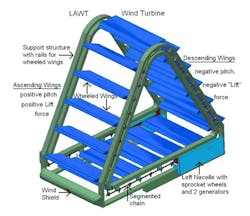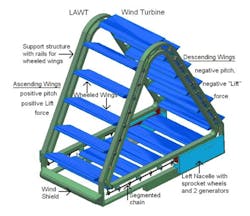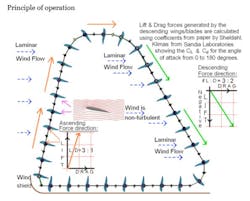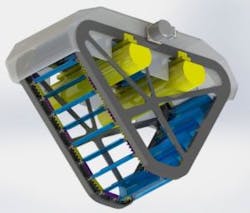Looks like a conveyor, works like a wind turbine
Those attending the recent Windpower 2013 exhibition could get a first-hand explanation of the Looped Airfoil Wind Turbine, a concept said to overcome shortcomings of horizontal wind turbines. Devised by a startup called EverLift Inc. in Nassau, Del., the device looks a little like a conveyor belt with airfoils for cleats. The airfoils cut through the wind and push the belt along. Electric generators would be driven by the moving chain via a rack-and-pinion setup.
The track to which the wings attach trace out the shape of a trapezoid. The wings drive chains or segmented rigid connectors. Housings (nacelles) hold connections from the track to the generators. A front “wind shield” prevents any braking drag force on “returning” wings.
One advantage of the scheme, say its inventors, is that both ascending and descending wings capture wind energy. And unlike ordinary horizontal wind turbines, the heavy parts of the appuratuse are at ground level.
The idea for the design arose when EverLift cofounder George Syrovy invented a novel vertical takeoff and landing aircraft that involved an intense investigation of helicopter rotors, basically rotating wings. Eventually Syrovy noticed that horizontal wind turbine rotors have helicopter-like blades embodying all the limitations of rotary winged aircraft.
The insight led to the idea of capturing wind energy using multiple airfoils in the manner of fixed-wing aircraft. Moreover, the LAWT design appears to work equally well in both wind and flowing water. And because water is some 780 times more dense than air, a hydro version of the LAWT could be much smaller than those for wind energy.
So far, though, the company has not built a working model of its concept. It was at the Wind Power show looking for a manufacturing partner. It says the first (non-working) hydro LAWT model built at the University of Southern Maine was about three feet high and four feet wide. EverLift says it has yet to determine the exact size of the first functioning hydro LAWT, but figures it will be of the same order of magnitude as this model.
When EverLift gets around to devising a working model, it hopes to equip it with at least two and perhaps as many as eight generators. Outward-facing gear teeth on the moving track will engage pinion gears on each generator. But there are other possible solutions if this method proves to be less than optimal. Plans also call for extruding the airfoils and then simply cutting them to the required length as a way of keeping down costs.
About the Author
Leland Teschler
Lee Teschler served as Editor-in-Chief of Machine Design until 2014. He holds a B.S. Engineering from the University of Michigan; a B.S. Electrical Engineering from the University of Michigan; and an MBA from Cleveland State University. Prior to joining Penton, Lee worked as a Communications design engineer for the U.S. Government.



